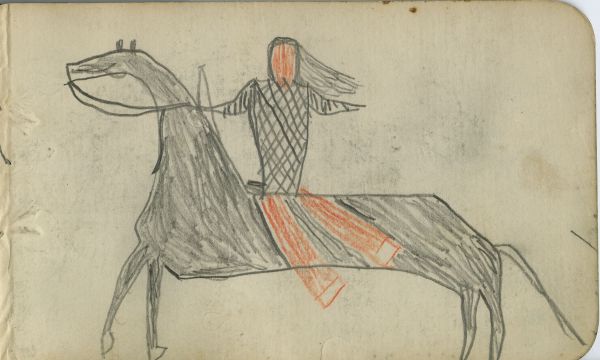HUNTING SCENE. Hunter on Black Horse Shoots Buffalo with Arrow
Ethnographic Notes
Drawn upside down in ledger. Two-page (diptych) HUNTING SCENE. In ledger art, action moves from the right-hand page to the left (See Candace Greene's article "Structure and Meaning in Cheyenne Ledger Art," 1996, for discussion of bilateral composition of most Cheyenne ledger art). Here the hunter on the horse has just released the arrow from his bow, and it has pierced the side of the buffalo on the left page. Inside Front Cover. HUNTING SCENE. The bison fills the page. The single arrow sticks from the profiled back. No blood runs from the wound or the animal's mouth, so this is the moment of impact. Shaggy hair is drawn on the top of the skull, along the neck, and fringing the front legs. The front left leg is raised. Media: Pencil outline and fill. p. 1. HUNTING SCENE. The hunter rides a large gray horse. His hair is loose, flying behind him, and his face is painted entirely with the orange pencil. The orange probably indicates red paint on the man�s face, a common color. He wears a cloth shirt of plaid or gingham, represented by crosshatched pencil lines. His arms are outstretched, as if he has just let loose of the arrow. His right hand holds a bow and the horse�s reins. His left hand is empty. His legs are not visible, but his breech clout flaps are visible against the horse�s flanks, parallel to his hair. They are orange pencil, probably intended to represent red trade cloth with undyed selvedges. The long clout is an identifier of Cheyenne men. The horse is outlined in lead pencil and pencil-filled except for the hooves. No saddle or decoration appears on the horse. A bridle of reins loops from the lower jaw. See Bonnie B. Kahn, "The Pamplin Ledger: Civilian, Indian, and Military Equipment" (2003), fig. 7a for illustration of reins.
Comment (2) All Comments For This Ledger
-
Denise Low
1/21/17, 7:55 PMShirt is gingham cloth.



Linea Sundstrom
9/4/12, 4:02 PM
Cheyenne-looking hair, red face paint, and breech cloth. Checked shirt?